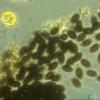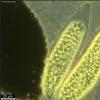
01-01-2026 18:35
Original loamy soil aside a artificial lake.The co

31-12-2025 19:27
Collected from loamy soil, at waterside (completel

30-12-2025 16:44
Pascal DucosBonjour,Une anamorphe rose stipitée, très nombre

30-12-2025 17:14
 Bernard CLESSE
Bernard CLESSE
Bonjour à toutes et tous,Pourriez-vous aider Albe

29-12-2025 10:15
Hulda Caroline HolteHello, I found and collected this propoloid ascom

30-12-2025 09:04
Hello.A Pyrenomycete sprouting sparsely but very d

29-12-2025 17:44
Isabelle CharissouBonjour,J'aimerais savoir si d'autres personnes au
I found this "Podospora" lato sensu on horse dung. It seems have 512 ascospores, according with some colleagues, but i calculated the asci and ascospores volume to obtain obtain an average estimate of how many spores could fit in the ascus, I considered about 80% of the ascus volume being occupied and got a total of approximately 2024 spores. I am not familiar with species that have this total, and those that do, like Podospora praecox and P. serotina, which have around 2048 spores (which is not too far off, considering a margin of error), have spores much smaller than mine. The spores I found are on average 18 x 11 micrometers, and the ascus measures approximately 250 micrometers in length by 120 micrometers in width. My sample closely resembles P. prolifica (around 1024-spored) due to the perithecium characteristics, and P. longicollis (around 512-spored) in terms of spore size. I did not observe appendages on the spores, even on the immature ones. Any suggestions?"
Thank you!
Calaça.

Nice to hear from you; I see you always find interesting species. According to Cailleux's work your mushroom could be close to P.praecox, but the absence of appendages on the spores is problematic unless they quickly collapsed, but I doubt it. You show hairs on the perithecium, what are they like? Could you take pictures?
Michel.
Yep, but I suppose these fungi simple found me in fact :-D
I read about your suggestion, but I not to certain about... Im working on Pseudoechria (https://www.facesoffungi.org/pseudoechria/), once some species resembles my material, specially Pseudoechria longicollis. See the images of perithecial hairs. What do you think? Can you send me this Cailleux's work? Im not certain if I have it...
See you!
Thanks,
Calaça.

Quite a few health issues, but life goes on!
I didn't know about this new genre, interesting! On the other hand, in your photos, the hairs don't seem to form tufts and we can't see the partitions. Were you able to observe the germinative pores?
I'll send you the article directly.
Best regards.
Michel.












